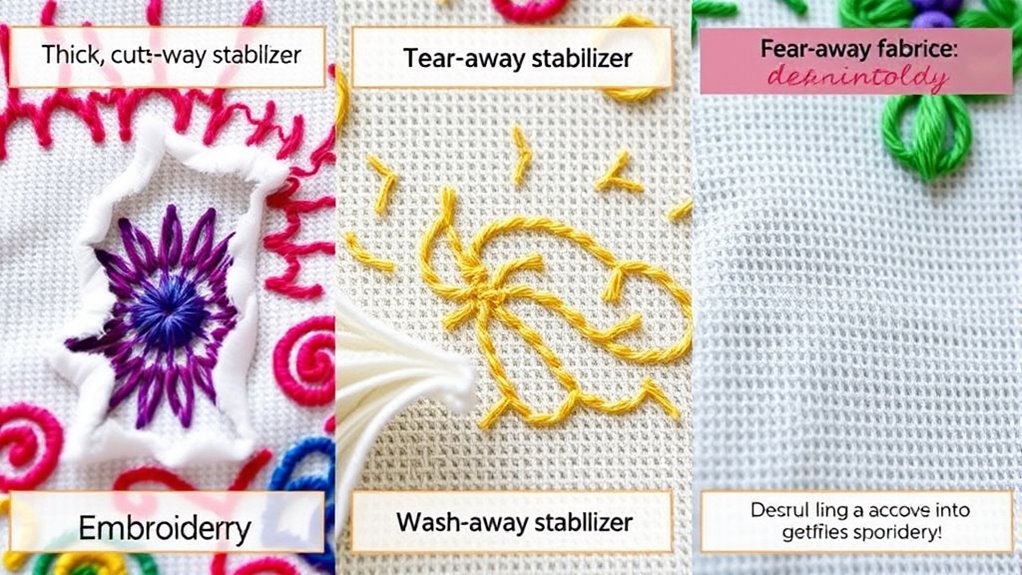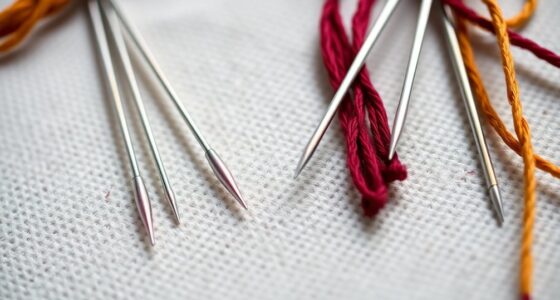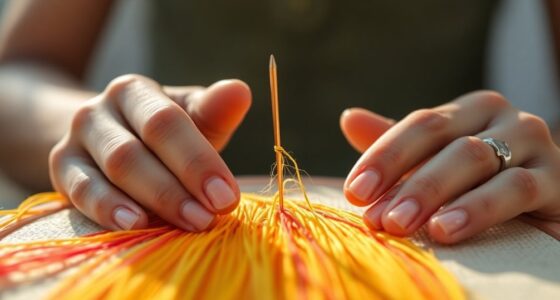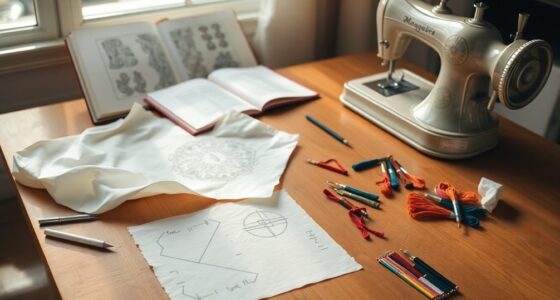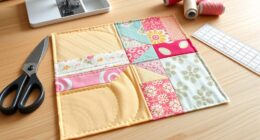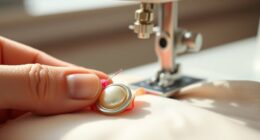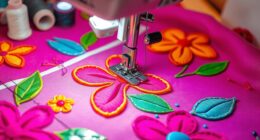Choosing the right embroidery stabilizer depends on your fabric and project. Tear-away stabilizers are easy to remove and great for lightweight or stretchy fabrics, while cut-away stabilizers provide permanent support for thicker or textured materials. Wash-away stabilizers are ideal for delicate fabrics like lace or chiffon, leaving no residue. Understanding these differences helps guarantee your designs stay smooth and professional. Keep exploring to discover more tips on selecting the best stabilizer for your projects.
Key Takeaways
- Cut-away stabilizers offer permanent support, ideal for thick or textured fabrics like denim.
- Tear-away stabilizers are suitable for lightweight or stretchy fabrics, providing easy removal after embroidery.
- Wash-away stabilizers dissolve in water, best for delicate fabrics such as lace or chiffon to avoid residue.
- Choice depends on fabric type, embroidery complexity, and project durability requirements.
- Proper stabilizer selection prevents puckering, ensures stitch quality, and enhances overall embroidery finish.

Have you ever struggled with puckering or distorted stitches when embroidery? If so, choosing the right stabilizer can make a huge difference. One of the key factors in selecting a stabilizer is understanding the different fabric types you work with and how various embroidery techniques influence your choice. Whether you’re stitching on delicate fabrics like silk or sturdy materials like denim, the right stabilizer ensures your design turns out smooth and professional.
When working with lightweight or stretchy fabrics, tear-away stabilizers often do the trick. They provide enough support during embroidery but can be easily torn away once your stitching is complete. This is especially useful if you’re doing intricate embroidery techniques that require precision, as it helps prevent puckering and distortion. For more delicate fabrics, such as lace or chiffon, a wash-away stabilizer might be better. These stabilizers dissolve in water, leaving a clean finish without any residue, which is essential for maintaining the fabric’s delicate texture.
If you’re handling thicker or more textured fabrics like canvas or denim, a cut-away stabilizer is usually your best choice. It offers permanent support, preventing stretching or puckering over time, especially when using dense embroidery techniques. Cut-away stabilizers are ideal for projects that require durability, like embroidery on clothing or accessories that will see frequent use. They also help maintain the integrity of complex designs, ensuring that your stitches stay even and true to your pattern.
Understanding the differences in stabilizer types helps you adapt your embroidery techniques accordingly. For example, you might use a tear-away stabilizer for quick, lightweight projects, but switch to a cut-away stabilizer for more durable, high-stress items. Similarly, for projects that need a clean edge or involve clear fabrics, wash-away stabilizers can be the perfect solution, dissolving after stitching to leave no trace. This knowledge allows you to choose the most appropriate stabilizer based on your fabric type and the specific embroidery techniques you’re employing.
Choosing the right stabilizer enhances embroidery durability and finish.
Additionally, material selection plays a crucial role in stabilizer choice, as different fabrics require different levels of support to achieve optimal results. Ultimately, selecting the right stabilizer involves considering the fabric’s weight, texture, and stretch, along with the complexity of your embroidery design. With the right choice, puckering and distortion become less of a concern, and your stitches stay crisp and professional. By experimenting with different stabilizers and understanding how they interact with various fabric types and embroidery techniques, you’ll refine your skills and produce embroidery projects that look polished and flawless every time.
Frequently Asked Questions
Can Stabilizers Be Reused for Multiple Embroidery Projects?
Stabilizers generally can’t be reused for multiple embroidery projects because they lose their support and structure after use. However, you can explore stabilizer recycling by opting for reusable stabilizer options like fusible or interfacing materials, which are designed to be used multiple times. These reusable stabilizer options save money and reduce waste, making them a smart choice if you frequently work on embroidery projects.
How Do I Choose the Right Stabilizer for Delicate Fabrics?
When choosing a stabilizer for delicate fabrics, opt for a light, soft stabilizer like a water-soluble or sheer tear-away to maintain fabric softness. These stabilizers provide gentle support without adding stiffness, allowing your stitches to have crisp definition. Test on a small piece first to verify the fabric’s texture remains smooth and the embroidery looks professional, keeping delicate fabrics looking beautiful and refined.
Are There Eco-Friendly Options for Embroidery Stabilizers?
Think of eco-friendly stabilizers as a gentle breeze for your projects. You can choose biodegradable options made from natural fibers or recycled materials that reduce waste and environmental impact. These stabilizers provide the support you need while being kind to the planet. Look for labels indicating sustainability, and you’ll find choices that help your embroidery flourish without harming the environment. It’s a win-win for your craft and the Earth.
How Do Stabilizers Affect the Durability of Embroidered Designs?
Stabilizers considerably impact your embroidered design’s durability by supporting fabric stretch and maintaining stitch integrity. They prevent puckering and shifting, which helps preserve color vibrancy over time. Using the right stabilizer for your fabric type ensures your design stays intact, even after multiple washes. Proper stabilizer choice reduces wear and tear, keeping your embroidery looking fresh, colorful, and durable for years to come.
Can Stabilizers Be Used With Metallic or Specialty Threads?
Yes, stabilizers can be used with metallic or specialty threads. You should choose stabilizers that provide enough support without adding bulk, especially for metallic thread compatibility. Light or tear-away stabilizers work well with delicate specialty threads, preventing puckering or breakage. Always test on scrap fabric first, as some stabilizers may affect the thread’s shine or texture, ensuring your embroidery stays smooth and professional.
Conclusion
Choosing the right embroidery stabilizer is like selecting the right foundation for a house—your design’s strength and beauty depend on it. Whether you opt for cut-away, tear-away, or wash-away, each acts as a guardian, supporting your creation through its journey. Remember, the stabilizer’s role is to nurture your craftsmanship, allowing your artistry to flourish. Trust in your choice, and let your embroidered masterpiece stand tall as a symbol of your skill and passion.
